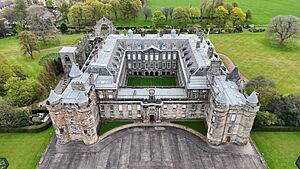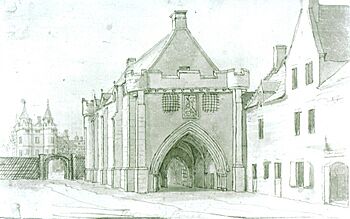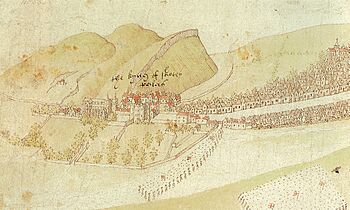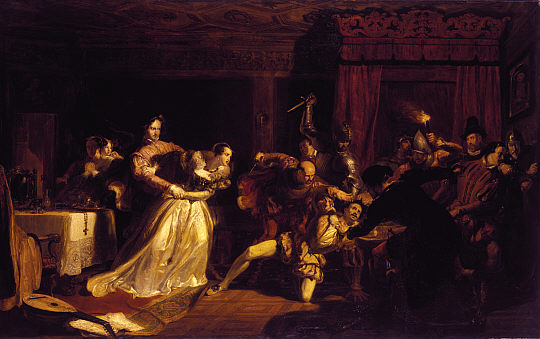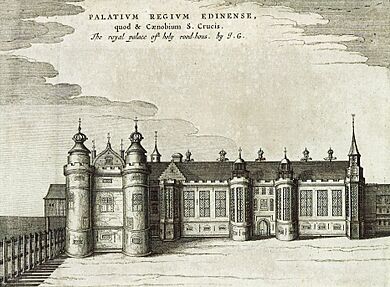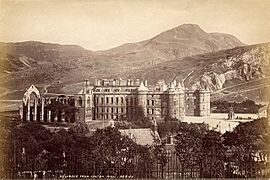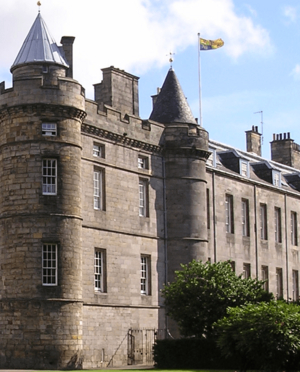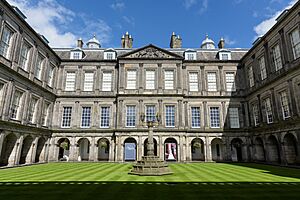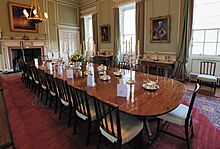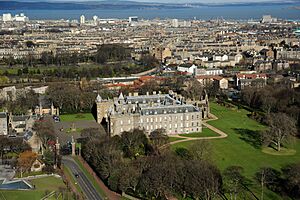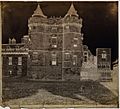Holyrood Palace facts for kids
Quick facts for kids Holyrood Palace |
|
|---|---|
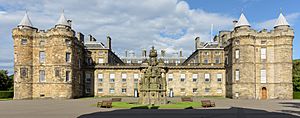
Holyrood Palace viewed from the forecourt
|
|
| General information | |
| Type | Official residence |
| Architectural style | Classical |
| Location | Royal Mile, Edinburgh, Scotland |
| Coordinates | 55°57′09″N 3°10′21″W / 55.95250°N 3.17250°W |
| Construction started | 1671 (north-west tower, 1528) |
| Completed | 1678 (north-west tower, 1536) |
| Owner | King Charles III in right of the Crown |
The Palace of Holyroodhouse, often called Holyrood Palace, is the official home of the British monarch in Scotland. It is located at the end of the Royal Mile in Edinburgh, with Edinburgh Castle at the other end. Since the 1500s, Holyrood has been the main royal palace in Scotland. It is used for state ceremonies and official events.
The palace is next to the ruins of Holyrood Abbey. Its gardens are part of the large Holyrood Park. In 2002, the King's Gallery opened at the palace's entrance. It displays art from the Royal Collection.
King Charles III stays at Holyrood for one week at the start of each summer. During this time, he holds many official events. The historic apartments of Mary, Queen of Scots, and the grand State Apartments are open to the public for most of the year. They only close when the royal family is visiting.
Contents
History of the Palace
The Abbey and Early Royal Home (12th–15th centuries)
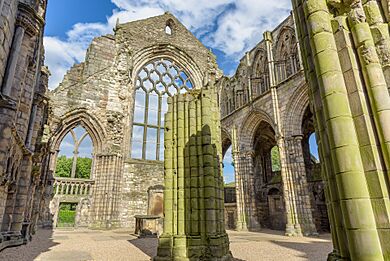
The story of Holyrood begins with Holyrood Abbey. King David I ordered it to be built in 1128. The name "Holyrood" means "Holy Cross." It might come from a legend about King David seeing a vision of a cross. Or it could be named after a piece of the True Cross that belonged to his mother, Saint Margaret.
Because it was a royal abbey near Edinburgh Castle, it became an important place. The Parliament of Scotland met there seven times. In 1328, Robert the Bruce signed the important Treaty of Edinburgh–Northampton in the 'King's Chamber' at the abbey. This shows that kings were already using it as a home. Several kings were born, crowned, married, or buried at Holyrood Abbey, including James II.
A Grand Palace is Built (16th century)
Between 1501 and 1505, James IV built a new palace next to the abbey. He likely did this for his marriage to Margaret Tudor in 1503. The palace had a chapel, a gallery, royal apartments, and a great hall.
His son, James V, added to the palace between 1528 and 1536. He built the large tower that is now the oldest part of the palace. This tower had new royal rooms and was built to be very secure, with a drawbridge.
In the 1540s, English armies attacked Edinburgh and damaged the palace and abbey. After this, the abbey was not well cared for and fell into ruin.
Mary, Queen of Scots at Holyrood
The royal apartments were home to Mary, Queen of Scots from 1561 to 1567. She held famous meetings with the Protestant leader John Knox in her audience chamber. She married her second husband, Henry Stewart, Lord Darnley, in the palace's chapel in 1565.
A famous and tragic event happened at the palace in 1566. Mary was having supper with her private secretary, David Rizzio, when Lord Darnley and a group of nobles burst in. They dragged Rizzio out of the room and killed him. A year later, Mary married her third husband, James Hepburn, 4th Earl of Bothwell, at the palace.
Her son, James VI, lived at Holyrood from 1579. His wife, Anne of Denmark, was crowned in Holyrood Abbey in 1590.
A New Look for the Palace (17th century)
In 1603, James VI also became King of England and Ireland. He moved to London, and Holyrood was no longer the home of a full-time royal court. In 1650, a fire badly damaged the palace while it was being used by Oliver Cromwell's soldiers.
After Charles II became king in 1660, the palace was rebuilt. The king's architect, Sir William Bruce, designed the palace much as we see it today. The work took place between 1671 and 1679. Bruce designed a beautiful courtyard and grand new apartments for the king and queen.
In the 1680s, the future King James VII and II lived at Holyrood. His court made Edinburgh a lively cultural center.
A Quiet Time and a Prince's Court (18th century)
After Scotland and England joined to form Great Britain in 1707, the palace became much quieter. The royal apartments were not used as much, and some nobles were given apartments there.
But in 1745, Holyrood came to life again. Charles Edward Stuart, also known as Bonnie Prince Charlie, set up his court at the palace for six weeks during the Jacobite Rising. He held grand balls in the Great Gallery.
During this time, the area around Holyrood Abbey was a "debtors' sanctuary." People who owed money could live there without being arrested.
A Royal Revival (19th century)
After the French Revolution, the younger brother of the French king was allowed to live at Holyrood. He stayed there from 1796 to 1803.
In 1822, King George IV made a famous visit to Scotland. He was the first reigning monarch to visit Holyrood since 1641. His visit sparked new interest in the palace. He ordered repairs but said that Queen Mary's historic rooms must be protected.
Queen Victoria loved Scotland and often stayed at Holyrood with her husband, Prince Albert. They renovated the royal apartments for their use. From 1854, the historic apartments in James V's Tower were officially opened to the public.
The Palace in Modern Times (20th century to today)
King George V turned Holyrood into a modern palace in the early 20th century. He had central heating, electric lights, and new bathrooms installed. The palace was officially named the monarch's residence in Scotland.
Each summer, the monarch spends a week at the palace, known as "Royal Week." During this time, they host garden parties and ceremonies. When the monarch is at the palace, the Royal Standard for Scotland is flown. At other times, the Royal Banner of Scotland is displayed.
After Queen Elizabeth II passed away at Balmoral Castle in September 2022, her coffin was brought to the palace. It rested in the Throne Room before being taken to St Giles' Cathedral.
Holyrood Palace has hosted many world leaders, including Nelson Mandela and Pope Benedict XVI. It remains an important center for royal and state events in Scotland.
Architecture of the Palace
The palace was mostly designed by Sir William Bruce in the 1670s. It is built around a central square courtyard, called a quadrangle. The design is in the Classical style, which was inspired by ancient Greek and Roman buildings.
The front of the palace has two towers. The north-west tower was built by James V in the 1500s. The south-west tower was built by Bruce to match it. Between the towers is the main entrance, decorated with the Royal arms of Scotland.
Inside the quadrangle, the walls have three levels of columns. Each level uses a different classical style: simple Doric on the ground floor, Ionic for the State Apartments on the first floor, and fancy Corinthian for the royal apartments on the second floor.
Inside the Palace
The palace has 289 rooms. The rooms open to the public include the State Apartments, the Great Gallery, and the historic rooms in James V's Tower.
The State Apartments
Visitors enter the State Apartments by the Great Stair. It has a beautiful ceiling with plaster angels holding the Honours of Scotland (the Scottish Crown Jewels).
The Throne Room was once the King's Guard Chamber. Today, it has two throne chairs made for King George V and Queen Mary in 1911. The walls are decorated with portraits of kings and queens.
The Morning Drawing Room is where the King gives private audiences to important people, like the First Minister. It has beautiful tapestries showing scenes from mythology.
The King's Bedchamber has the most amazing plaster ceiling in the palace, decorated with scenes of Hercules.
The Great Gallery
The Great Gallery is the largest room in the palace, at 45 meters (150 feet) long. It is famous for its collection of portraits of the Scottish monarchs. The Dutch painter Jacob de Wet was hired by Charles II to paint them between 1684 and 1686. There are 96 portraits, showing both real and legendary kings from Fergus I to James VII.
Bonnie Prince Charlie held dances in this room in 1745. Today, the gallery is used for large events like banquets and award ceremonies.
James V's Tower
This tower contains the oldest rooms in the palace. On the second floor are the apartments of Mary, Queen of Scots.
Mary, Queen of Scots' Outer Chamber is where she met with visitors, including John Knox. It is also the room where her secretary, David Rizzio, was attacked and killed.
Mary, Queen of Scots' Bedchamber has a beautiful oak ceiling from her time. It is decorated with the initials of her parents, James V and Mary of Guise.
Gardens and Grounds
The palace gardens cover about 10 acres and are part of the much larger Holyrood Park. A small building from the 16th century in the garden is known as Queen Mary's Bath House.
In the center of the front courtyard is a large stone fountain. It was built in 1858 and is a copy of a 16th-century fountain at Linlithgow Palace. The decorative iron gates at the entrance were added in 1920 as a memorial to King Edward VII.
Images for kids
-
George IV in Highland Dress, 1829. Sir David Wilkie's portrait of the kilted king hangs in the Royal Dining Room.
See also
 In Spanish: Palacio de Holyrood para niños
In Spanish: Palacio de Holyrood para niños
- Holyrood (disambiguation)
- Historic Environment Scotland (Executive agency of the Scottish Government responsible for Holyrood Abbey)


